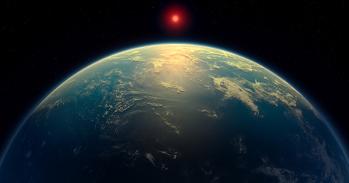
A team of astronomers at the University of Cambridge is taking the next big step in a European-wide programme which will lead to the creation of the first three-dimensional map of more than a billion stars.
A team of astronomers at the University of Cambridge is taking the next big step in a European-wide programme which will lead to the creation of the first three-dimensional map of more than a billion stars.
As Gaia slowly spins, it will create a billion-pixel video of the Milky Way, watching everything move, and deducing what is there, and where it is.
Professor Gerry Gilmore
A powerful data centre being turned on today at the Institute for Astronomy (IoA) will process the vast amount of imaging data sent back to Earth by a satellite which is due to be launched into space in August 2013. The Gaia satellite, whose heart is the largest digital camera ever built, will orbit the Sun at a distance of 1.5 million km from Earth and will feed the data centre with a billion-pixel video of a billion stars, galaxies, quasars and solar system asteroids for five years after launch.
The installation of the data centre, funded by the UK Space Agency, coincides with the 50th Anniversary of the launch of the British satellite research programme, Ariel-1, which was devoted to studying the ionosphere - a part of the upper atmosphere.
The Gaia satellite, which has been hailed as the premier European astrophysics space mission of the decade, will deliver an extraordinarily precise census of the Milky Way in three dimensions.
“As Gaia slowly spins, it will create a billion-pixel video of the Milky Way, watching everything move, and deducing what is there, and where it is,” explained Professor Gerry Gilmore, from the IoA and the UK Principal Investigator for UK involvement in the mission. “On its five-year mission, Gaia will produce a vast amount of information - almost inconceivable in its scope.”
In 1989, the European Space Agency (ESA) launched Hipparcos, the first –and so far the only - satellite to chart the positions of stars, which produced a primary catalogue of about 118,000 stars, followed by a secondary catalogue, called Tycho, of over 2 million stars.
Technology has improved to such an extent since Hipparcos was launched that Gaia will be able to measure a star’s position and motion 200 times more accurately, and will measure one billion stars.
In order to process Gaia's photometric data, the team has worked for several years to develop a system that can calibrate the 'raw' transmitted photometric data. Even highly compressed, the data transmitted by the satellite over the five-year mission would fill over 30,000 CDROMs (1300 DVDs). Many times that amount will be produced during the processing of the data as intermediate results of computations.
The new installation consists of a cluster of 108 identical servers used for the bulk of the data processing, and 9 additional servers used for monitoring, backup and control. The 108 processing servers each have 2 6-core CPUs, 48 gigabytes of RAM and 9 terabytes (a terabyte is 1000 gigabytes) of hard-disk storage. Therefore the bulk processing system as a whole has 1296 processing cores, around 5 terabytes of RAM and nearly 1 petabyte (1000 terabytes) of hard-disk storage for use during the active processing. The individual servers are connected by a high-speed 40 gigabit Infiniband network to allow rapid communication and transfers of large data volumes.
The system will process the photometric data from Gaia during the 5-6 years of mission operation, and for two years afterwards, to produce a calibrated set of measurements which can be freely used by the astronomical community.
Dr Floor van Leeuwen, from the IoA, is project manager and coordinator of the consortium that will process the Gaia photometric data, which involves 60 scientists across Europe, of the 400 in total in the Gaia project. “We installed our major computer processing capability, and now are very busy bring together the huge processing effort which will use this impressive hardware system to turn images into science. We need to be ready for Gaia’s launch, just next year After so many years preparation, this is excitingly, but challengingly, soon.” he said.
Gaia is one of the most important current space projects for the UK, which has won approximately €80 million of contracts from ESA to build parts of the spacecraft.
Remarkably, its two optical telescopes are capable of measuring the positions of celestial objects to an accuracy of up to 10 microarcseconds, comparable to the diameter of a human hair at a distance of 1000 km. To determine the properties of stars, Gaia will also split their emitted light into a spectrum before communicating the data back to Earth.
After launch, a 10 m diameter ‘skirt’ will unfold around the satellite to shade the telescopes and generate its own energy from solar panels.
Gaia is expected to discover a multitude of new objects both in our solar system - including brown dwarfs and white dwarfs, supernovae and extra-solar planets - as well probe the distribution of dark matter , map over 500,000 quasars in the Universe, and measure the local structure of space-time.
Added Gilmore: “By creating the first precise 3-D chart of our galaxy, Gaia will help scientists understand the enormous range of complexities related to the origin, structure and evolution of our Milky Way, the past history of the Sun’s location in the Milky Way, and the time and place where the chemical elements of which we are made were created, as well as discover new objects, from potentially killer asteroids to explosions in the distant Universe.”
This work is licensed under a Creative Commons Licence. If you use this content on your site please link back to this page.





